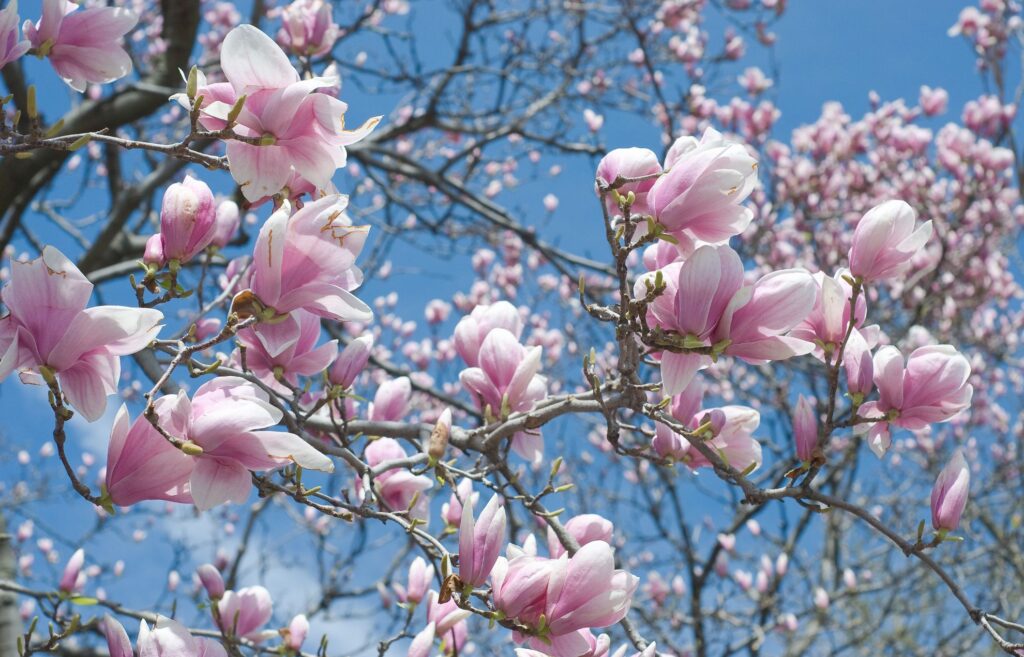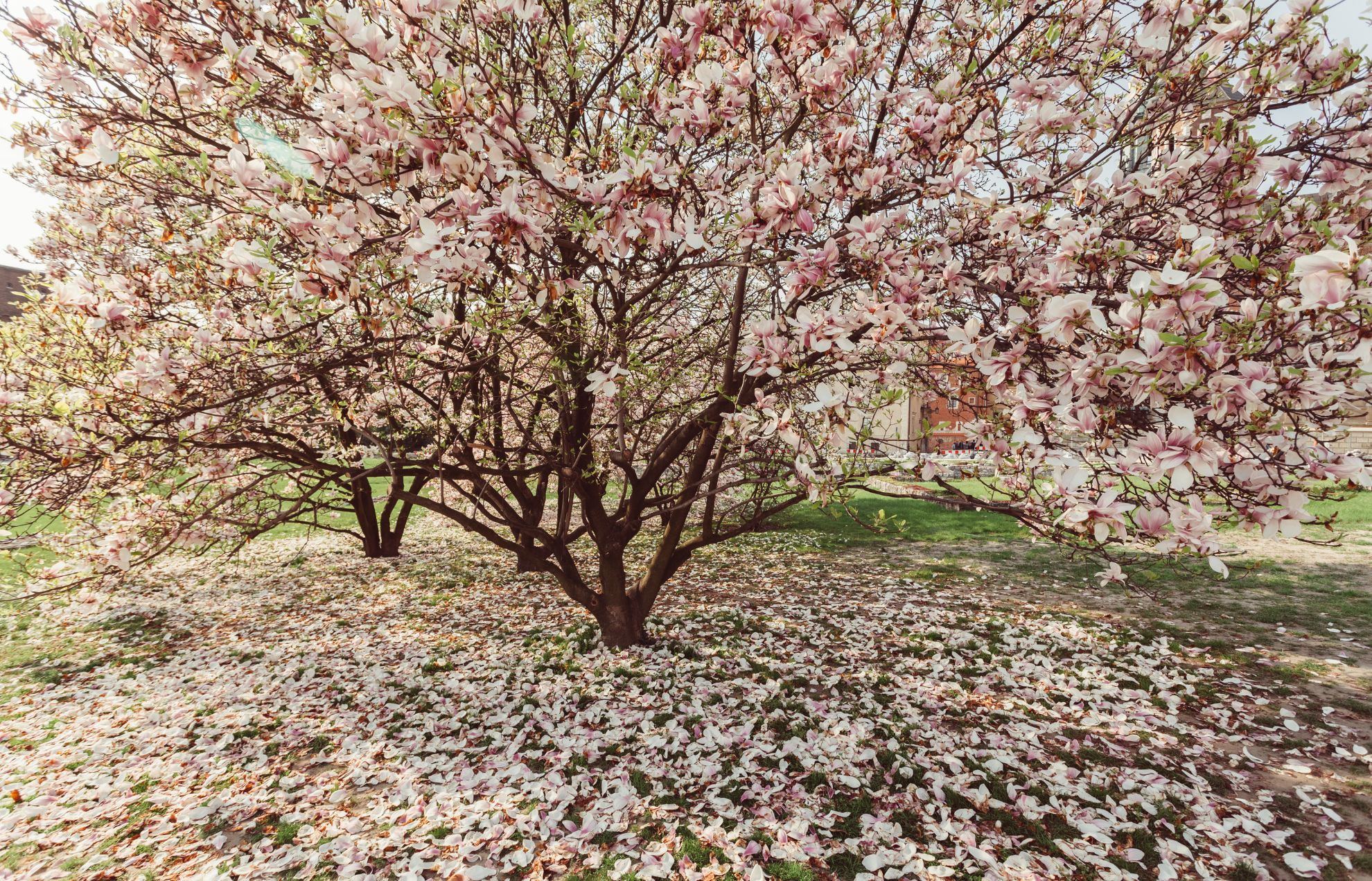When to Prune Magnolia
With their fragrant flowers and lush green leaves, magnolia trees add year-round beauty to landscapes. Proper pruning is essential to keeping these trees healthy and encouraging magnificent blooms. But when is the right time to prune magnolia trees?
In this blog, we will explore the best time to prune a magnolia tree in the UK, the reasons why magnolia trees specifically need pruning, the essential pruning techniques, and the significance of professional tree surgeons.
So, if you have a magnolia tree in your garden or are considering planting one, keep reading for some expert tips on pruning your magnolia tree.
What are Magnolias?
Magnolias are attractive trees known for their large, showy flowers that bloom in early spring. They come in a variety of varieties, including deciduous magnolias, which shed their leaves in autumn, and evergreen magnolias, which retain their leaves year-round.
Magnolia trees are a popular choice for gardens and landscapes, as they add a touch of beauty and elegance with their stunning flowers. Many varieties of magnolias stay relatively compact, making them suitable for small gardens and spaces.

What is Tree Pruning?
Tree pruning is the process of selectively removing branches or parts of a tree to promote healthy growth, shape, and overall tree health. Pruning helps maintain the size, shape, and overall appearance of the tree, as well as remove dead, damaged, or diseased branches, improving the tree’s overall health and safety.
It is a common practice used by horticulturalists, tree surgeons, and arborists to manage the growth of trees.
Why Magnolia Trees Specifically Need Pruning
Magnolia trees, like any tree, benefit from pruning to maintain overall shape, ensure a healthy, attractive appearance, and improve overall tree health. Pruning magnolia trees specifically helps with the following aspects:
- Maintaining shape: Pruning magnolia trees helps maintain the overall shape of the tree, ensuring a healthy, attractive appearance.
- Improving tree health: Pruning magnolia trees removes dead, damaged, or diseased branches, improving the overall health of the tree.
- Promoting flower growth: Proper pruning of magnolia trees can promote the growth of flower buds, leading to a full bloom of the tree’s stunning flowers.
- Enhancing overall beauty: Pruning lower branches of magnolia trees gives them a cleaner, more attractive appearance, especially in small gardens.
- Removing unsightly growth: Pruning magnolia trees allows for the removal of weak, damaged, or unsightly growth, enhancing the overall beauty of the tree.
When Is The Right Time to Prune a Magnolia Tree in the UK
In the UK, the best time to prune magnolia trees is during late winter or early spring, before the tree begins to bloom.
This time of year ensures that the tree is dormant, reducing the risk of damage to new growth. Late winter pruning allows the tree to shape, removing dead branches, and damaged growth, and maintaining overall tree health.
In late summer or early autumn, it is advisable to prune magnolias to a lesser extent. This pruning should focus on the removal of dead branches and damaged growth, preparing the tree for the winter months.
However, heavy pruning during late fall should be avoided, as it can stimulate new growth that may not harden off before winter, leading to potential damage.
For evergreen magnolias, such as the evergreen magnolia grandiflora, early fall pruning, before the onset of winter weather, is recommended. Pruning deciduous magnolias, on the other hand, is best done in late winter, before the tree begins to bloom, ensuring healthy growth and full bloom of the tree’s stunning flowers.
Signs Your Magnolia Tree Needs Pruning
Knowing when your magnolia tree needs pruning is essential for its overall health and growth. Look out for the following signs, which indicate your magnolia tree may need pruning:
- Disease signs: Discoloured or diseased branches are a clear signal that pruning is necessary to maintain the tree’s health.
- Unsightly shape: If the overall shape of your magnolia tree is unsightly, pruning can help restore a healthy, attractive shape.
- Damaged growth: Remove lower branches or water shoots that are detracting from the natural fork of the tree, improving its overall appearance.
- Risk of storm damage: It may be a good idea to prune injured branches, especially if they pose a risk of storm damage.
- Weak growth: If your magnolia tree is weak and showing signs of weak growth, pruning can help promote healthier growth, ensuring the tree’s overall well-being.
The Art of Pruning: Essential Techniques
Pruning magnolia trees requires a delicate touch and the knowledge of essential pruning techniques. Let’s explore the best practices for pruning magnolia trees, focusing on the differences between pruning deciduous and evergreen magnolias, as well as common pruning mistakes to avoid.
Pruning Deciduous versus Evergreen Magnolias
The pruning techniques for deciduous magnolias, which shed their leaves in autumn, differ from those of evergreen magnolias, which retain their leaves year-round. Here are the essential pruning tips for each type of magnolia tree:
- Deciduous magnolias: Prune deciduous magnolias in late winter or early spring, before new growth starts. When pruning, prune just above a natural fork or branch collar, taking care not to leave unsightly stubs.
- Evergreen magnolias: Prune evergreen magnolias, such as the evergreen magnolia grandiflora, in late summer or early fall, after the tree has finished flowering. Remove branches that are injured, diseased, or damaged, ensuring the overall health of the tree.
Common Pruning Mistakes to Avoid
While pruning magnolia trees, it is important to avoid common pruning mistakes, which can damage the tree and hinder healthy growth. Here are a few pruning mistakes to avoid:
- Heavy pruning: Avoid heavy pruning, as it can lead to weak growth and unsightly stubs, detracting from the overall appearance of the tree.
- Late summer pruning: Do not prune your magnolia tree during late summer, as it may stimulate new growth that won’t have time to harden off before winter, making the tree vulnerable to damage.
- Early winter pruning: Avoid pruning your magnolia tree too early in the year, as pruning during late winter can damage the tree and reduce its blooming potential.
- Pruning bare branches: Do not prune your magnolia tree if the branches are still bare, as pruning during this time can lead to storm damage and overall tree stress.
- Lower bough pruning: Avoid pruning lower boughs of mature magnolia trees, as it can damage the tree’s overall shape, leading to a less attractive appearance.

The Significance of Professional Tree Surgeons
While pruning magnolia trees can be a rewarding task, it is best left to the professionals for the best care of your tree.
Professional tree surgeons have the expertise, knowledge, and necessary equipment to prune your magnolia tree safely and effectively, ensuring healthy growth and a beautiful shape.
Here are a few reasons why hiring a professional tree surgeon is significant:
- Expert pruning: Professional tree surgeons have the expertise to prune your magnolia tree properly, promoting healthy growth, shape, and overall tree health.
- Identification of disease: Tree surgeons can identify signs of disease or damage that may require pruning, ensuring the overall health of your magnolia tree.
- Safety: Professional tree surgeons have the necessary equipment and knowledge to prune your magnolia tree safely, preventing accidents and damage.
- Time-saving: Hiring a tree surgeon saves you time and effort, as they can efficiently prune your magnolia tree, allowing you to focus on other aspects of your garden.
Why Should You Not Overprune Your Magnolia Tree?
While pruning is important for the overall health of your magnolia tree, it is equally important not to overprune, as it can have detrimental effects. Here are a few reasons why you should avoid overpruning your magnolia tree:
- Weakening the tree: Overpruning can weaken the magnolia tree, leading to lower flower production and overall tree health.
- Water shoots growth: Overpruning a magnolia tree can result in the growth of weak, vertical shoots known as water shoots, which take energy away from the tree, affecting its overall growth.
- Vulnerability to disease and damage: Overpruning a magnolia tree can leave it vulnerable to disease and damage from harsh weather conditions, compromising the tree’s overall health.
- Disruption of natural growth pattern: Overpruning can disrupt the natural growth pattern of the magnolia tree, making it look unbalanced and unsightly.
- Maintaining natural shape: Magnolia trees are best pruned to maintain their natural shape, rather than to conform to a specific size or shape, ensuring the tree’s overall beauty.
Summary of When To Prune a Magnolia
Armed with the insider knowledge in this pruning guide, you’ll be able to care for your magnolia trees confidently. By following the best practices for your magnolia type, you can enjoy prolific flowers and lush growth for years to come.
If you’re unsure of how to prune your trees, consider contacting a qualified tree professional to work on your magnolia trees as they will be correctly insured and competently trained to carry out such work. Some people may over-prune a magnolia tree, which can shorten the lifespan of the tree and reduce its ability to heal. It can allow viruses and pathogens to damage the tree.
At Evolution Tree Surgery, we offer tree care services and tree pruning for residential and commercial customers in Newbury and the surrounding areas in Berkshire.
For a free quote to prune your magnolia tree, call Evolution Tree Surgery in Newbury at 07917 195806 .
Related Guides & Advice:
- How Much Does Tree Surgery Cost?
- Essential Types of Tree Pruning Techniques
- How to Prune a Silver Birch Tree
- What is a Tree Surgeon?
- How to Prune an Apple Tree
- When is the Best Time to Cut Trees Back
- How to Choose a Tree Surgeon
- Our Hedge Removal Guide
- What is Tree Felling?
- Common Types & Symptoms of Tree Disease
- How and When to Prune a Cherry Tree

